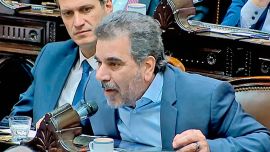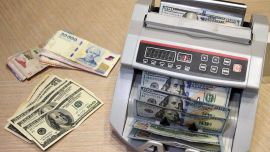Today’s 75th Peronist Loyalty Day does not find the movement in its happiest moment amid coronavirus pandemic, economic slump and monetary chaos with nothing better to mark the red-letter day than the formality of offering President Alberto Fernández the Justicialist Party (PJ) chairmanship. But Peronism has known other grim anniversaries – the 10th came a month after Juan Domingo Perón’s overthrow, the 30th with the ramshackle government of his widow visibly falling apart even ahead of the 1976 coup a few months away and even the Golden Anniversary under a recently re-elected Carlos Menem in 1995 could not be celebrated by all comrades since his presidency was a walking contradiction of those lines in the Peronist March: “la gran masa del pueblo combatiendo el capital.” The 40th and 70th anniversaries were less dramatic but both coincided with electoral defeats that same spring. At least this anniversary finds Peronism in power.
But let us go back to the beginning: October 17, 1945, when 700 Berisso meat-packers under Cipriano Reyes marching for Perón’s release mushroomed into at least 300,000 workers in the main crowd converging on Plaza de Mayo and perhaps a million overall. Four months later Perón was elected to the first of 37 years of Peronist presidency in the ensuing 75 years (with only six years of non-Peronist government since 1989), a turning-point in Argentine history.
That election revolved around the slogan “Braden or Perón,” the first of many polarisations since then and perhaps one of the most misleadingly simplistic as conveying an image of Yankee imperialism versus populist nationalism, left versus right. Yet in fact United States Ambassador Spruille Braden hailed from the far left of the Democratic Party under former Vice-President Henry Wallace (the Bernie Sanders of his times) and his only concern was to stop a fascism which had just been defeated worldwide and which he identified with Perón. Not inaccurately (what passed as Peronist ideology was steeped in Benito Mussolini’s corporatism) but also simplistic – thus the supposedly neo-Nazi Perón was one of the first world leaders to recognise Israel only nine months after the Jewish state’s creation, not to mention all the bewildering variations since then in a movement whose ideology has never stopped moving.
The decline and fall of Argentina in the last 75 years, under Peronist government half the time and military rule almost a quarter, has been amply chronicled and no real need to repeat it here. Instead it could be worth asking how those 75 years might have unfolded if Loyalty Day had not swept Perón to power. Differently for sure but not necessarily better. The Unión Democrática alternative in 1946 spanning the entire political spectrum from conservatives to Communism in an ideological kaleidoscope exceeding Peronism offered no guarantees of cohesive government and nor is there any reason to think that its Radical leadership was better equipped to resist two-pronged military and trade union pressures than future party colleagues.
Peronism did surprisingly little to change the economic model (inheriting rather than inventing import substitution, contrary to common belief). Where Perón did transform Argentina, with massive state intervention and the empowerment of organised labour, has contributed two major negative factors to the country’s decline but also has its plus points – a bloated and corrupt bureaucracy but also a panoply of welfare services which have so far protected the social fabric from the full devastation of the pandemic. Pre-1945 Argentina with its oligarchy of 40,000-50,000 could live within its means whereas today’s Argentina with at least two million high-maintenance citizens cannot but that traditional society represented a market bottleneck which had to go one way or another.
No room for all the twists and turns (including a couple of years of Peronism without Perón) but it is also worth pointing out how much this ultra-nationalist movement has been influenced by the outside world – Perón by the Bandung Conference of 1955 creating the Third World, Menem by the Washington Consensus following the Berlin Wall, Kirchnerism by its strong regional context, etc.
And where does it go from here? Perhaps history will mark last Monday’s massive banderazo march as a new October 17 taking Argentina in an entirely direction in future decades, but perhaps not – who can tell? One final point – modern Argentine journalism would be unimaginable without Peronism. In conclusion we might steal a choice phrase from Billy Connolly in ironic defence of the Catholic-Protestant rivalries of his native Glasgow: “Peronism (bigotry in the original) is like smoking – you know it’s bad for you but it’s fun.”






















Comments